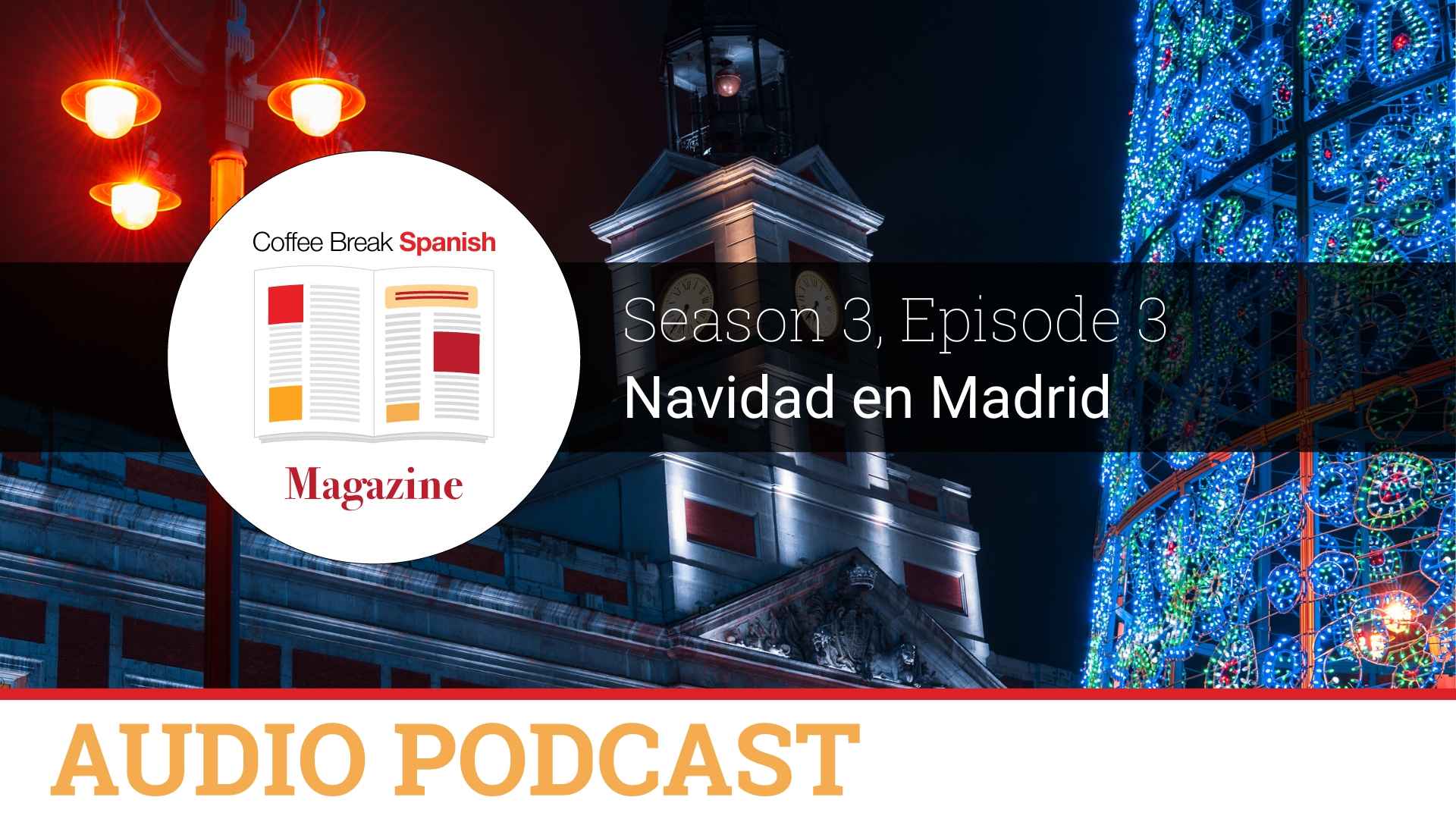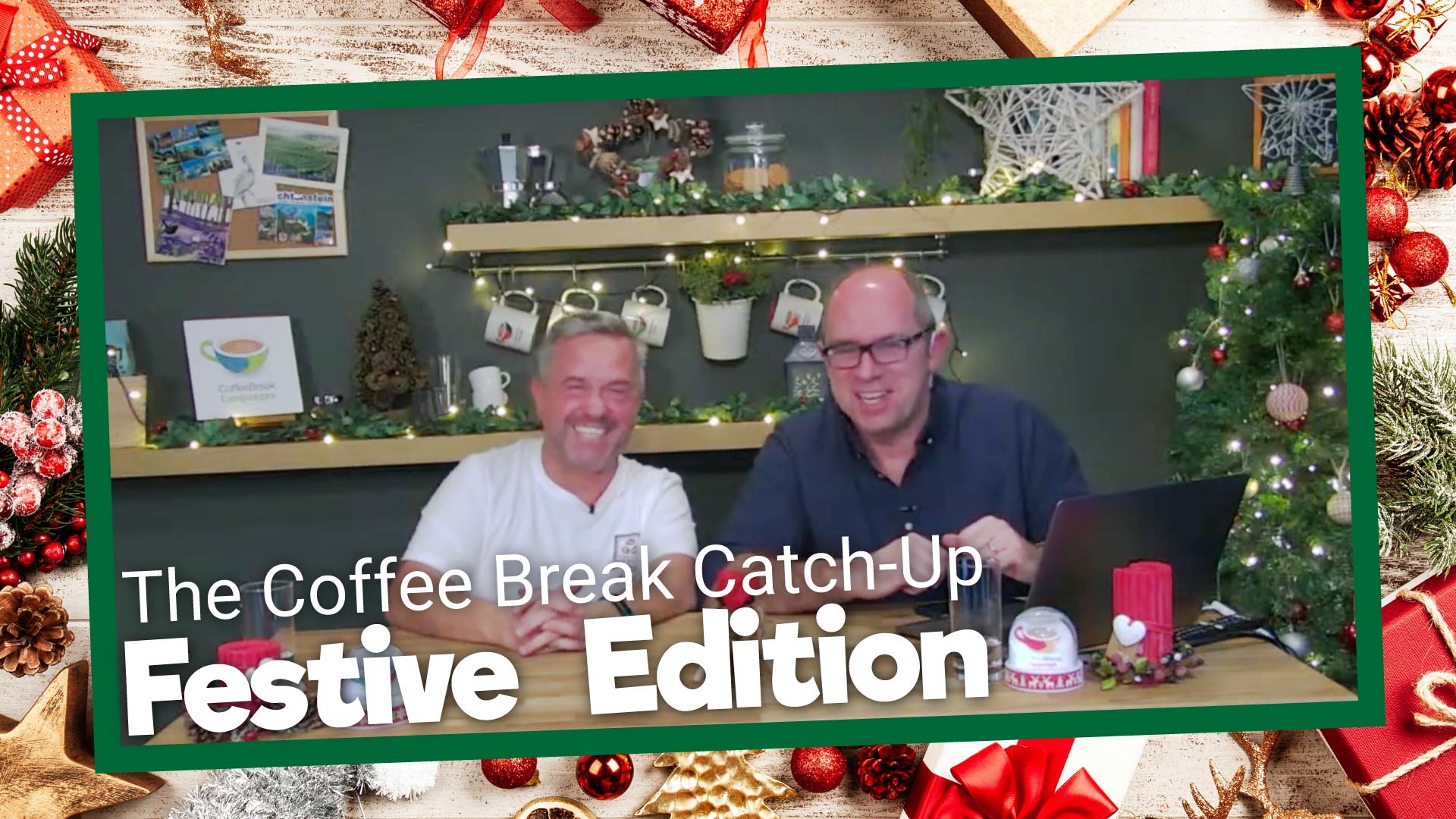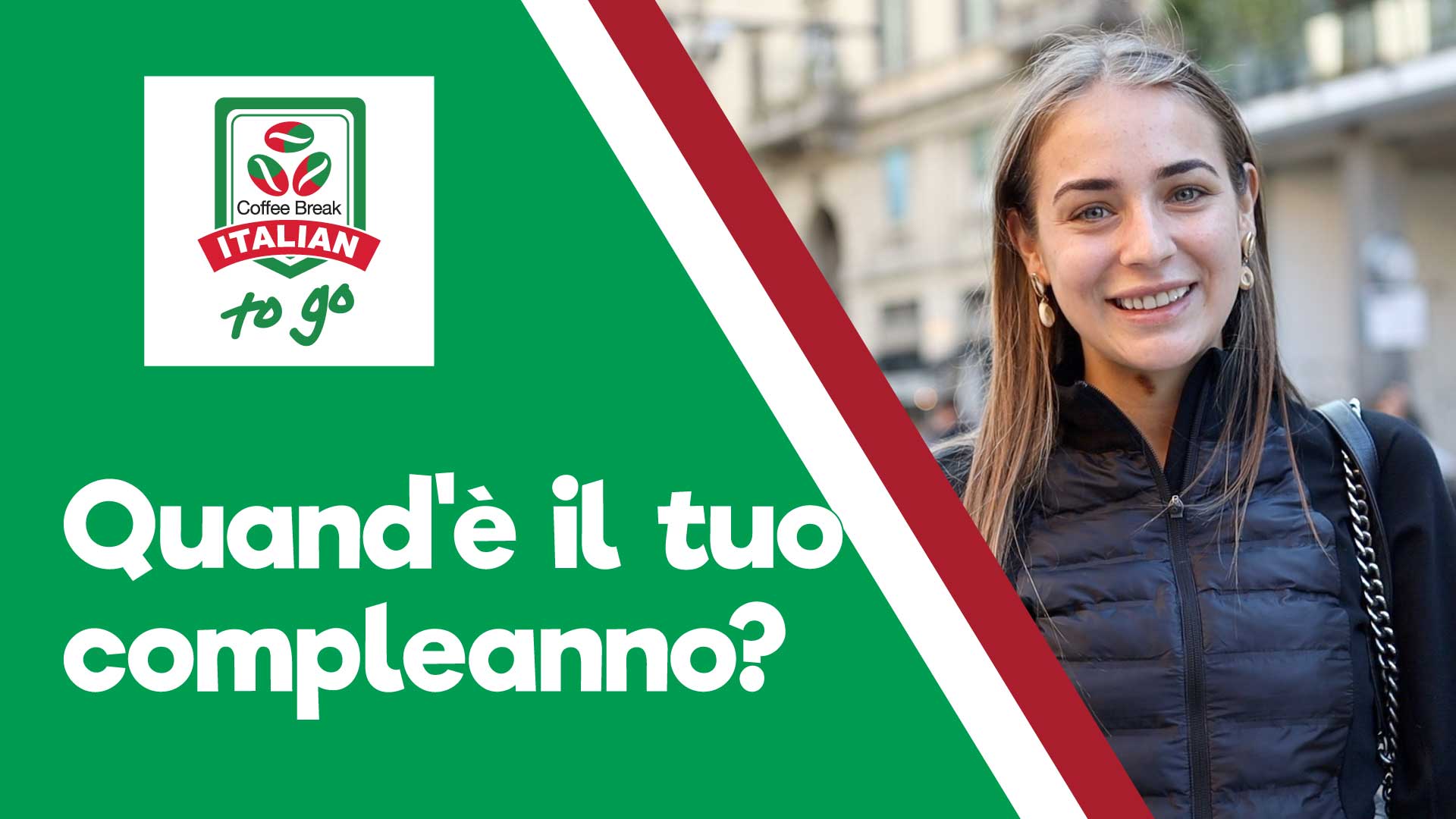It’s time for a festive episode of the Coffee Break Spanish Magazine. In this lesson, Anabel joins Mark and Fernanda to discuss Navidad en Madrid and together they discuss festive traditions in the Spanish capital. There’s a question from listener Sarah about developing listening skills, and Anabel also shares a useful idiomatic expression which is linked to this time of year. The expression involves El Gordo, the famous lottery drawn at Christmas. If you’d like to watch this year’s adverts for El Gordo, click here.
Month: December 2019
A Festive Edition of the Coffee Break Catch-Up
Join Mark and Pierre-Benoît for the final Catch-Up of the year in which they update you on all things Coffee Break and discuss festive traditions in different countries, including the famous Catalan caga tió, the “pooing log”!
Quand êtes-vous né(e) ? – “When were you born?” – Coffee Break French To Go Episode 5
To ask “when were you born?” in French you can say quand es-tu né(e) ?, or in a more formal situation, quand êtes-vous né(e) ? In this episode of Coffee Break French To Go, Pierre-Benoît asks this questions to interviewees in the streets of his hometown, Pornic. You can use the answers of our interviewees to help you learn to answer this question yourself.
In the first part of the video, watch the interviews without subtitles and try to understand. In the second part of the video, we’ve provided subtitles in French at the top of the screen. You can choose to turn on subtitles in English using the Subtitles/CC button.
In this first series of Coffee Break French To Go, Pierre-Benoît is in the town of Pornic, in the west of France, and in each episode she’ll ask passers-by one question. Of course, that one question will result in many answers, and it’s through these answers that you can practise your French and build your vocabulary.
Coffee Break French To Go will be published every two weeks here on YouTube, and each Season will be filmed in a different part of the French-speaking world.
If you’d prefer not to wait for all 10 lessons of Season 1 to be published, you can access downloadable versions of the videos along with audio versions and lesson notes / transcripts in the Coffee Break Academy.
Coffee Break French To Go is based on the popular podcast series and online course Coffee Break French. For access to the free podcasts, please click here.
To purchase our full online courses on the Coffee Break Academy, click here.
Quand’è il tuo compleanno? / Quand’è il suo compleanno? – Coffee Break Italian To Go Episode 5
In this episode Francesca’s question is “Quand’è il tuo compleanno?” – “When is your birthday?”. Using the answers you’ll learn to say when your birthday is in Italian. Here are the words and phrases you’ll need:
When is your birthday? – Quand’è il tuo compleanno? (informal)
When is your birthday? – Quand’è il suo compleanno? (formal)
My birthday is … Il mio compleanno è il…
In the first part of the video, watch the interviews without subtitles and try to understand. In the second part of the video, we’ve provided subtitles in Italian at the top of the screen. You can choose to turn on subtitles in English using the Subtitles/CC button.
In this first series of Coffee Break Italian To Go, Francesca is in the town of Milan, in the north of Italy, and in each episode she’ll ask passers-by one question. Of course, that one question will result in many answers, and it’s through these answers that you can practise your Italian and build your vocabulary.
Coffee Break Italian To Go will be published every two weeks here on YouTube, and each Season will be filmed in a different part of the Italian-speaking world.
If you’d prefer not to wait for all 10 lessons of Season 1 to be published, you can access downloadable versions of the videos along with audio versions and lesson notes / transcripts in the Coffee Break Academy.
Coffee Break Italian To Go is based on the popular podcast series and online course Coffee Break Italian. For access to the free podcasts, please click here.
To purchase our full online courses on the Coffee Break Academy, click here.
CBG Mag 1.08 | 300 Jahre Liechtenstein
In this episode of the Coffee Break German Magazine we’re heading to the Principality of Liechtenstein, sandwiched between Austria and Switzerland. Europe’s fourth-smallest country it’s one of only two doubly landlocked countries in the world (the other being Uzbekistan!) Find out more about this small German-speaking country and its 300th anniversary in this episode. In addition Olivera is back with another long German word.
Celebrate the festive season by singing in 10 languages!
Here at Coffee Break Languages, we hope that you find the time this festive season to relax at home, spend time with family and catch up with friends. As you know, we like to provide you with ways to fit a little bit of language learning into whatever you’re doing. And what better opportunity to do this than to introduce your family and friends to some songs for this festive season from all over the world, and in a number of different languages?
You may have already listened to our Tune for Tuesday YouTube and Spotify playlists. There is one for Italian, French, Spanish and German, and a multilingual playlist containing all the songs together. And now, it’s time for Tune for Tuesday – Festive Edition! We’ve compiled a multilingual playlist of songs that are sung around the world to celebrate a number of different festivals and holidays at this time of year to help you practise your language skills while joining in the festivities. You can listen to Tune for Tuesday – Festive Edition on YouTube and on Spotify by clicking on the links at the bottom of the page.
But for now, we’ll introduce you to some of the songs in our festive playlist, in Italian, German, French and Spanish, while learning more about how the festive season is celebrated in some of the countries where these languages are spoken.
A Natale puoi
LINKS: Lyrics | English translation
In Italy, Christmas is all about religion, family, and food, of course! The festive season starts on the 8th of December which, according to the Christian tradition, is the Feast of the Immaculate Conception. On this day, each family decorates their Christmas tree and creates a representation of the nativity scene, also called presepe. Presepe is a very well-known Italian tradition: everyone recreates the nativity scene with little statuettes, and sometimes it is considered a real art form. On Christmas Eve, people have a huge dinner with their relatives: usually there are even more than five courses! Everyone stays up until midnight, and then it’s officially Christmas Day. On the 25th, children find their presents under the Christmas tree which Babbo Natale (Santa Claus) brought them overnight. Adults also exchange gifts, and after going to church people have another long lunch with relatives. The most popular Christmas food is probably pandoro or panettone. They are both sweet breads, but whereas the former is covered in icing sugar, panettone has either raisins or chocolate chips inside. Another very famous treat is torrone. Torrone is a nougat confection made of sugar, honey, egg whites and nuts, and is usually eaten at the end of a meal. The last day of the Christmas Holidays is the 6th of January, day of the Epiphany. On this day good children get sweets and treats, whereas naughty children only get coal! Since the 6th marks the end of Christmas, it is also the day when everyone puts away their Christmas tree and presepe.
Now you know a little more about the festive season in Italy, have a listen to A Natale puoi, a Christmas song which is very popular in Italy. Here, it is sung by Roberta Bonanno, an Italian singer who started her career after reaching second place on the popular Italian talent show, Amici di Maria di Filippi, in the 2007-2008 season. There are also Italian versions of many of the popular Christmas songs in English, such as Bianca Natale and Oh albero. Can you guess which Christmas songs in English these are referring to? Try looking them up on YouTube if you’d like to listen to them.
Fröhliche Weihnacht überall
LINKS: Lyrics | English translation
The festive season in Germany is primarily characterised by Christmas celebrations, which have become an integral part of German culture and tradition. Germans use this time to unite with their families and be merry together. The family reunion is often celebrated with a big Christmas dinner and the opening of presents on Christmas Eve. As a part of these festivities, traditional foods are prepared. One slightly more peculiar dish is now considered an integral part of the table, the Kartoffelsalat (potato salad). Originally introduced in connection with the Christian tradition of lent, this potato dish is enjoyed in all kinds of variations around German tables at Christmas. The Christmas dinner is often followed by decorating the Christmas tree and singing together – there is simply no better way of spreading Christmas joy throughout the night. Germans have written some beautiful Christmas songs specifically for this occasion. The traditional classics include O Tannenbaum, Fröhliche Weihnacht überall and Oh du fröhliche, to name just a few. However, the Christmas festivities start long before the arrival of Christmas Eve. On the 6th of December, Saint Nikolaus arrives and leaves chocolate, nuts and fruit in the winter boots of the children who have been good. From that day on, the wait for Christmas Eve is filled by a range of merry activities, such as visiting a traditional Weihnachtsmarkt (Christmas market) and drinking Glühwein (mulled wine). But what would German Christmas time be without its most important tradition: the Weihnachtsbäckerei (Christmas baking). As a part of this, young and old come together to create the most delicious Christmas treats, such as Lebkuchen, Zimtsterne and Christstollen.
One of the festive songs in our playlist is Fröhliche Weihnacht überall which, as mentioned above, is a very popular song at this time of year in Germany. This version is sung by German singer, actress and TV presenter, Helene Fischer, and appears on her 2015 Christmas album, Weihnachten. Her music is often associated with the style known as Schlager, a style of popular music from Central and Northern Europe that has similarities with what is often know as country music, and five of her albums have been the best-selling albums of the year in Germany.
Entre le bœuf et l’âne gris
LINKS: Lyrics | English translation
The festive season in Belgium is also generally based on Christian values and begins around the 6th of December, Saint Nicholas Day, when children are left gifts during the night. It continues all the way up to Epiphany, on the 6th of January. During that last feast, families gather around a pie which hides a small figurine inside. Whoever bites into the slice with the figurine is the king for the following year and can wear a crown for the evening. This idea is in reference to the three kings in the nativity scene. Between these two dates, Christmas markets are open across most cities, offering vin chaud (mulled wine) and beignets powdered in sugar. The cougnou, a traditional Christmas pastry, is very popular among Belgians. Made with flour, milk, eggs, sugar and either raisins or chocolate chips, cougnous have a distinct oval shape with two rounded bundles on each end. This, funnily enough, is an attempt to recreate the shape of baby Jesus wrapped up in the manger. Most Belgians spend Christmas Eve with close family and gifts are exchanged that evening. Santa Claus is not recognised so much in Belgium, as Saint Nicholas Day is celebrated earlier in the month instead. The 25th is often spent with more family members, even more food and presents. While New Year’s Eve is almost exclusively a big party, Christmas is a time for love and sharing. Finally, because Belgium is a monarchy, the King delivers a speech in retrospect of the year, both in French and Dutch.
Entre le bœuf et l’âne gris is a Christmas carol which is popular in a number of French-speaking countries. It is one of the oldest French carols and has been recorded by many different choirs and individual artists, including Claire Pelletier. There are also French versions of many of the popular Christmas songs in English, such as Douce nuit and Mon beau sapin. Can you guess which Christmas songs in English these are referring to? Try looking them up on YouTube to find more festive songs in French.
Campana sobre campana
LINKS: Lyrics | English translation
In Panama, a Spanish-speaking country in Central America which borders Costa Rica and Colombia, the festive season is generally based on religious traditions. The festivities begin for some families with the lighting up of the advent wreath on the first Sunday in December, and for others, they begin on the 8th of December with Mother’s Day, which intentionally coincides with the Feast of Immaculate Conception. The 16th of December marks the start of the novenas for many families. The novenas are a typical tradition in Latin American countries, where families gather around the nine days before Christmas to pray and tell the story of Jesus. Other families also do posadas, which are gatherings where people sing Christmas carols. The main event during this season is Christmas Eve, where families gather together and eat a big dinner with typical festive dishes such as: ham, turkey, potatoes, salad and arroz con guandú, which is rice with a special type of seasonal beans. After eating dinner, people wait patiently until midnight, when they greet each other and often enjoy fireworks while kids open their presents. On Christmas morning, it is very common to eat the leftovers from dinner for breakfast! New Year’s Eve follows a similar pattern, where families wait for midnight to celebrate the new year with fireworks. Since the capital, Panama City, is relatively close to beaches, some people spend New Year’s Eve in their beach houses, where they stay up all night to see the sunrise. The festive season finishes on the 6th of January with la llegada de los reyes magos (the Epiphany). On this day, children receive small gifts. The festive season in Panama is focused on spending time with family and loved ones, where gifts are welcomed but not compulsory, because the most important thing is gathering the family together.
Many of the most popular Spanish Christmas songs are well-known in Spain and throughout Latin America, including Campana sobre campana. You can find the lyrics online by clicking on the link above. We’d recommend reading them as you listen to the song, as there may be a few unfamiliar words relating to the Christmas story.
We hope you’re now feeling in the festive spirit and ready to listen to some more songs in the language you’re learning. The four songs mentioned above are all in our Tune for Tuesday – Festive Edition playlist, which you can find on YouTube and on Spotify by clicking on the links below. But for now, we’ll wish you Buon Natale, Fröhliche Weihnachten, Joyeux Noël, Feliz Navidad and Merry Christmas!
Tune for Tuesday – Festive Edition: YouTube playlist | Spotify playlist
The Coffee Break Catch-Up: 5 December 2019
Join Coffee Break founder and CEO Mark Pentleton for our weekly live broadcast in which we update you on all things Coffee Break, from our latest podcast episodes and videos to what’s been happening on our social profiles. Coming up in this edition:
- the latest episodes of our Coffee Break German and Spanish Magazines;
- news for language-learning music lovers;
- the announcement of our Black Friday Prize Draw winners;
- cultural updates from around the world.
If you’d like to access all the links for this episode and practise your reading skills in the language you’re learning, click here to sign up for our weekly language and culture newsletter.
Quel âge as-tu ? / Quel âge avez-vous? – “How old are you?” – Coffee Break French To Go Episode 4
In French when you talk about ages you don’t say “I am 21 years old”: instead you say “I have 21 years”. Equally, when you ask the question “how old are you?” or “what age are you”, you actually ask “what age do you have”. Here are the phrases you’ll need:
I’m (21) years old – j’ai (21) ans
How old are you? (informal) – Quel âge as-tu ?
How old are you? (formal) – Quel âge avez-vous?
In the first part of the video, watch the interviews without subtitles and try to understand. In the second part of the video, we’ve provided subtitles in French at the top of the screen. You can choose to turn on subtitles in English using the Subtitles/CC button.
In this first series of Coffee Break French To Go, Pierre-Benoît is in the town of Pornic, in the west of France, and in each episode she’ll ask passers-by one question. Of course, that one question will result in many answers, and it’s through these answers that you can practise your French and build your vocabulary.
Coffee Break French To Go will be published every two weeks here on YouTube, and each Season will be filmed in a different part of the French-speaking world.
If you’d prefer not to wait for all 10 lessons of Season 1 to be published, you can access downloadable versions of the videos along with audio versions and lesson notes / transcripts in the Coffee Break Academy.
Coffee Break French To Go is based on the popular podcast series and online course Coffee Break French. For access to the free podcasts, please click here.
To purchase our full online courses on the Coffee Break Academy, click here.
Quanti anni hai? / Quanti anni ha? – “How old are you?” – Coffee Break Italian To Go Episode 4
In Italian when you talk about ages you don’t say “I am 21 years old”: instead you say “I have 21 years”. Equally, when you ask the question “how old are you?” or “what age are you”, you actually ask “how many years do you have”. Here are the phrases you’ll need:
I’m (21) years old – ho (21) anni
How old are you? (informal) – quanti anni hai?
How old are you? (formal) – quanti anni ha?
In the first part of the video, watch the interviews without subtitles and try to understand. In the second part of the video, we’ve provided subtitles in Italian at the top of the screen. You can choose to turn on subtitles in English using the Subtitles/CC button.
In this first series of Coffee Break Italian To Go, Francesca is in the town of Milan, in the north of Italy, and in each episode she’ll ask passers-by one question. Of course, that one question will result in many answers, and it’s through these answers that you can practise your Italian and build your vocabulary.
Coffee Break Italian To Go will be published every two weeks here on YouTube, and each Season will be filmed in a different part of the Italian-speaking world.
If you’d prefer not to wait for all 10 lessons of Season 1 to be published, you can access downloadable versions of the videos along with audio versions and lesson notes / transcripts in the Coffee Break Academy.
Coffee Break Italian To Go is based on the popular podcast series and online course Coffee Break Italian. For access to the free podcasts, please click here.
To purchase our full online courses on the Coffee Break Academy, click here.










